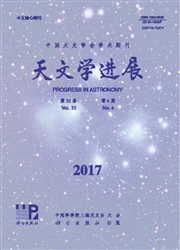

 中文摘要:
中文摘要:
太阳高能粒子(SEP)事件是一类重要的空间天气灾害性事件,其数值预报研究在空间天气预报研究中占有很重要的地位。SEP事件主要包括3种类型:与太阳耀斑爆发相关联的脉冲型事件,与日冕物质抛射驱动的激波相关联的缓变型事件,以及同时具有缓变型和脉冲型事件特征的混合型事件。其中,缓变型SEP事件持续时间较长并且高能粒子强度较大,对这类事件的模拟是当前研究的难点。目前针对缓变型SEP事件的模拟工作业己发展了多个理论和数值模型。每个模型都对SEP加速和传播的复杂过程作了基本的假设,这些模型的模拟结果能够部分重现观测到的SEP事件特征。而若要提高预报SEP事件的能力,则需要将描述三维日冕物质抛射驱动的激波模型与描述高能粒子在行星际空间中的加速和传输的模型耦合起来,建立基于接近真实的SEP加速和传播的三维太阳风背景模拟及以激波参数为输入的SEP模型。主要回顾了缓变型SEP事件中粒子的加速和传输方面的研究进展,以及可用于获取CME激波传播参数的磁流体力学太阳风模型研究现状;综述了缓变型SEP事件的激波一粒子模型(shock—and—particle model);最后对未来工作进行了讨论和展望。
 英文摘要:
英文摘要:
Solar energetic particle (SEP) can destroy the spacecraft, and has great influence on human activities. Thus, it is of importance to forecast SEP events. SEP events can be divided by three general categories: impulsive SEP events, gradual SEP events and mixed SEP events. Impulsive SEP events, with characteristics of low intensity, short duration, and enhanced He-3, are correlated to solar flares. Gradual SEP events which become the main simulation branch of current research are related to coronal mass ejections (CMEs) and they usually have high flux in protons and last longer. Mixed SEP events maintain complex features of the former two kinds of events. Several theories and numerical models are applied to simulate gradual SEP events. Each model makes some assumptions to simplify the complex acceleration and transportation processes. No research to date has combined accurate shock evolution, particles injection and acceleration, with their interplanetary transport. In order to develop the physics-based SEP prediction model and improve the ability to forecast SEP events, it is necessary to self- consistently combine the magnetohydrodynamic (MHD) model that describes CME-driven shock propagation with particle model that simulates the acceleration and transportation processes of particles. In this paper, firstly, we review current models, which have been used to describe gradual SEP events and their applications. Generally, there are two major approaches to model gradual SEP events: some studies include the acceleration mechanisms of SEPs induced by CME-driven shocks, while others assume a fixed particle injecting source at the shock. In addition, some researchers also consider the effects of perpendicular diffusion on SEPs propagation in three-dimensional interplanetary magnetic fields. These models can partially reproduce the observed properties for SEP events. Then, we make a brief review of numerical MHD simulation models, such as Space Weather Modeling Frame (SWMF), CORonal and HELiospheric
 同期刊论文项目
同期刊论文项目
 同项目期刊论文
同项目期刊论文
 Three-dimensional MHD simulation of the evolution of the April 2000 CME event and its induced shocks
Three-dimensional MHD simulation of the evolution of the April 2000 CME event and its induced shocks The role of cross-shock potential on pickup ion shock acceleration in the framework of focused trans
The role of cross-shock potential on pickup ion shock acceleration in the framework of focused trans Energy spectrum of energetic particles accelerated by shock waves: from focused transport to diffusi
Energy spectrum of energetic particles accelerated by shock waves: from focused transport to diffusi Modeling of Solar Active Region Using a Three-Dimensional, Time-Dependent, Data-Driven Magnetohydrod
Modeling of Solar Active Region Using a Three-Dimensional, Time-Dependent, Data-Driven Magnetohydrod Using a 3D spherical plasmoid to interpret the Sun-to-Earth propagation of the 4 November 1997 coron
Using a 3D spherical plasmoid to interpret the Sun-to-Earth propagation of the 4 November 1997 coron Energy transfer during intense geomagnetic storms driven by interplanetary coronal mass ejections an
Energy transfer during intense geomagnetic storms driven by interplanetary coronal mass ejections an 期刊信息
期刊信息
